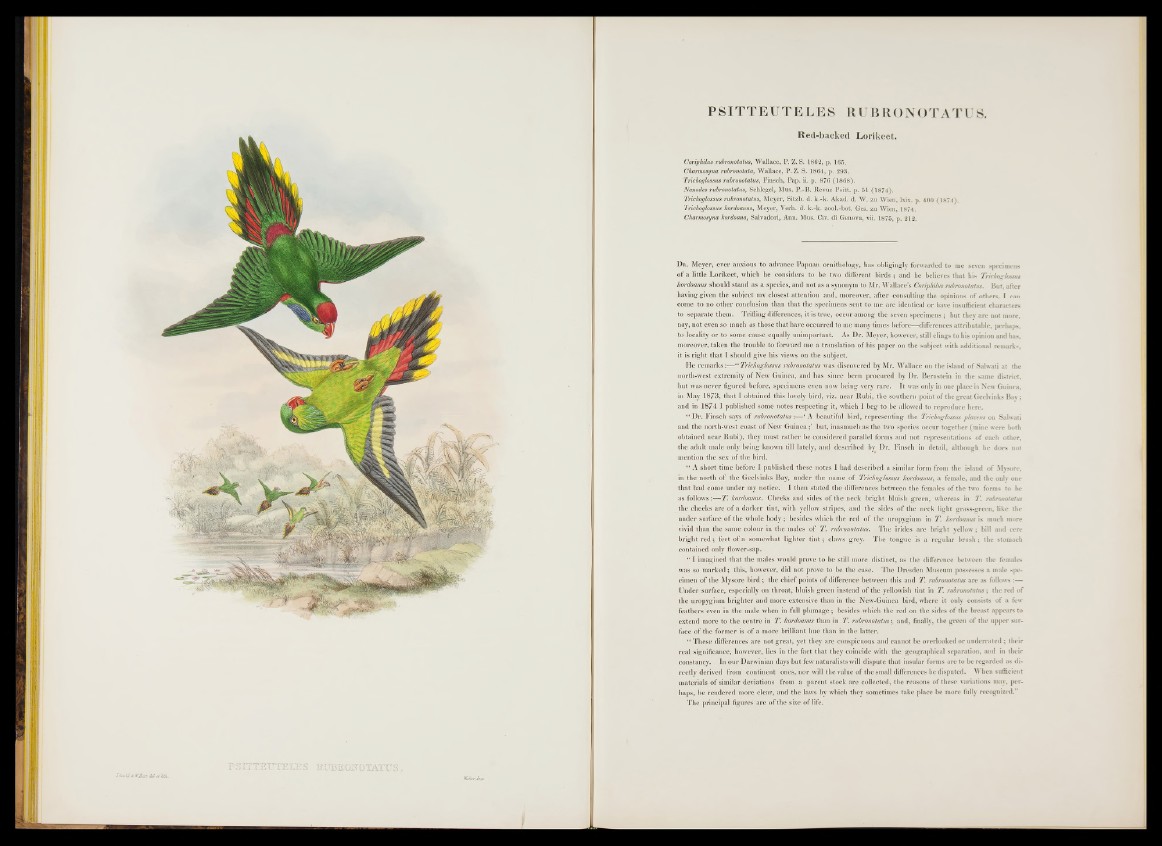
3TJTE1 ES JS.UBSOTOTAXUS
PSITTEUTELES RUBRONOTATUS.
Red-backed Lorikeet.
Coriphilus rubronotatus, Wallace, P. Z. S. 1862, p. 166.
Charmosyna rubronotata, Wallace, P. Z. S. 1864, p. 293.
Trichoglossus rubronotatus, Finsch, Pap. ii. p. 876 (1868).
Nano des rubronotatus, Schlegel, Mus. P.-B. Revue Psitt. p. 51 (1874).
Trichoglossus rubronotatus, Meyer, Sitzb. d. k.-k. Akad. d. W. zu Wien, lxix. p. 400 (1874).
Trichoglossus kordoanus, Meyer, Verh. d. k.-k. zool.-bot. Ges. zu Wien, 1874.
Charmosyna kordoana, Salvadori, Ann. Mus. Civ. di Genova, vii. 1875, p. 212.
D r. Meyer, ever anxious to advance Papuan ornithology, has obligingly forwarded to me seven specimens
o f a little Lorikeet, which he considers to be two different birds ; and he believes that his Trichoglossus
kordoanus should stand as a species, and not as a synonym to Mr. W allace’s Coriphilus rubronotatus. But, after
having given the subject my closest attention and, moreover, after consulting the opinions o f others, I can
come to no other conclusion than that the specimens sent to me are identical or have insufficient characters
to separate them. Trifling differences, it is true, occur among the seven specimens ; hut they are not more,
nay, not even so much as those that have occurred to me many times before—differences attributable, perhaps,
to locality o r to some cause equally unimportant. As Dr. Meyer, however, still clings to his opinion and has,
moreover, taken the trouble to forward me a translation o f his paper on the subject with additional remarks,
it is right th at I should give his views on the subject.
He rem a rk s:— “ Trichoglossus rubronotatus was discovered by Mr. Wallace on the island o f Salwati at the
north-west extremity o f New Guinea, and has since been procured by Dr. Bernstein in the same district,
hut was never figured before, specimens even now being very rare. I t was only in one place in N ew Guinea,
in May 1873, th at I obtained this lovely bird, viz. near Rubi, the southern point o f the g reat Geelvinks B a v ;
and in 1874 I published some notes respecting it, which I beg to be allowed to reproduce here.
“ D r. Finsch says o f rubronotatus:—‘ A beautiful bird, representing the Trichoglossus placens on Salwati
and the north-west coast o f New Guinea;’ but, inasmuch as the two species occur together (mine were both
obtained near Rubi), they must rath er he considered parallel forms and not representations o f each other,
the adult male only being known till lately, and described by Dr. Finsch in detail, although he does not
mention the sex o f the bird.
“ A short time before I published these notes I had described a similar form from the island o f Mysore,
in the north o f the Geelvinks Bay, under the name o f Trichoglossus kordoanus, a female, and the only one
th at had come under my notice. I then stated the differences between the females o f the two forms to be
as follows :— T . kordoanus. Cheeks and sides o f the neck bright bluish green, whereas in T. rubronotatus
the cheeks are o f a darker tint, with yellow stripes, and the sides o f the neck light grass-green, like the
under surface o f the whole b o d y ; besides which the red o f the uropygium in T . kordoanus is much more
vivid than the same colour in the males o f T . rubronotatus. The irides are bright yellow; bill aud cere
bright r e d ; feet o f a somewhat lighter t in t ; claws grey. The tongue is a regular brush ; the stomach
contained only flower-sap.
“ I imagined th at the males would prove to be still more distinct, as the difference between the females
was so marked ; this, however, did not prove to be the case. T h e Dresden Museum possesses a male s.pe-
cimen o f the Mysore b ird ; the chief points o f difference between this and T. rubronotatus are as follows :—
Under surface, especially on throat, bluish green instead o f the yellowish tint in T. rubronotatus; the red of
the uropygium brighter and more extensive than in the New-Guinea bird, where it only consists o f a few
feathers even in the male when in full plumage; besides which the red on the sides o f the breast appears to
extend more to the centre in T . kordoanus than in T. rubronotatus; and, finally, the green of the upper surface
o f the former is o f a more brilliant hue than in the latter.
“ These differences are not g reat, yet they are conspicuous and cannot be overlooked o r underrated ; their
real significance, however, lies in the fact th at they coincide with the geographical separation, and in their
constancy. In our D arwinian days but few naturalists will dispute that insular forms are to be regarded as directly
derived from continent ones, nor will the value of the small differences he disputed. W hen sufficient
materials o f similar deviations from a parent stock are collected, the reasons o f these variations may, perhaps,
be rendered more clear, and the laws by which they sometimes take place be more fully recognized.”
The principal figures are o f the size o f life.